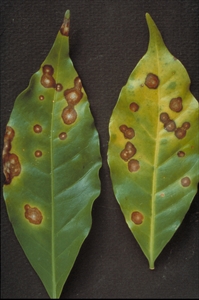Coffee spot, berry blotch, coffee brown eye spot
Pacific Pests, Pathogens, Weeds & Pesticides - Online edition
Pacific Pests, Pathogens, Weeds & Pesticides
Coffee brown-eye spot (142)
Mycosphaerella coffeicola; this is the name of the sexual form of the fungus; the disease is also known by the asexual form, Cercospora coffeicola.
Asia, Africa, North, South, and Central America, the Caribbean, Oceania. It is recorded from American Samoa, Australia, Cook Islands, Fiji, French Polynesia, Federated States of Micronesia, New Caledonia, Papua New Guinea, Samoa, and Vanuatu.
Coffee arabica, Coffea canephora
Small brown spots occur on the leaves, more obvious on the upper surface (Photo 1). The spots occur within the leaf, mostly between the veins, and also at the margins. The spots can grow up to 15 mm diameter; they have light brown or sometimes light grey centres, surrounded by a wide, dark brown ring, and a yellow margin (Photo 2). Sometimes, the spots grow into large blotches, and a leaf blight occurs. This usually happens in cooler, wet areas above 600 m.
On the berries, the infections are smaller than on leaves, less than 5 mm wide, but sometimes they cover the whole berry. Generally, they are more irregular in shape than on the leaves, brown, and mainly on the side exposed to the sun. The spots on the berries may begin when they are still green.
Weather conditions are important for this disease: high humidity, rain, warm temperatures and drought stress after flowering all favour it. Spore masses of the fungus can be seen in the grey centres of the leaf spots and on blackened ripe berries. The spores are spread by wind and rain splash, and need water to germinate.
Often, other fungi invade the berries following infections of Cercospora. The fungus, Colletotrichum gloeosporiodes is commonly present.
The disease is usually a problem when coffee plants are not growing well because of poor nutrition or too little shade. In nurseries, it can cause leaf fall of seedlings and, in severe cases, stem dieback. Generally, it is less important on mature plants, although, when conditions favour the disease, epidemics occur on even well-maintained trees.
When berries are infected, they ripen before the beans are mature, and this can result in off flavours when the coffee is processed. Often, the berries shrivel after infection, and some fall. In Samoa, the disease is most severe on the berries.
Look for the characteristic spots on the leaves with light brown (sometimes grey) centres, brown outside, surrounded by yellow margins. Look for brown irregular to oval spots on the berries.
CULTURAL CONTROL
Cultural control is important; there are a number of ways that it can be used to reduce the impact of the disease in nurseries and plantations.
- Nurseries:
o Arrange the seedlings so that air moves between the rows and leaves dry as quickly as possible.
o Provide the plants with adequate nutrition, especially sufficient nitrogen and potassium.
- Plantations:
o Minimise plant stress: provide recommended nutrition, paying particular attention to nitrogen and potassium; and provide adequate drainage.
o Plant coffee at recommended spacing, and provide 35-65% shade.
o Prune the bushes to improve air movement in the canopy.
o Do not leave debris from pruning the bushes in the field - spores in the debris can reinfect leaves and berries.
CHEMICAL CONTROL
Nutrition and shade should be improved before chemical control is considered. If it is required, in nurseries or plantations, use:
- Protectant products: Coppers.
- Systemic products: Triazoles.
Three spays of copper usually applied monthly beginning at flowering are usually enough to provide control of this fungus. Note, that copper fungicides may kill the insects that give biological control of the green scale insect, Coccus viridis.
____________________
When using a pesticide, always wear protective clothing and follow the instructions on the product label, such as dosage, timing of application, and pre-harvest interval. Recommendations will vary with the crop and system of cultivation. Expert advice on the most appropriate pesticides to use should always be sought from local agricultural authorities.
AUTHOR Grahame Jackson
Information from Gerlach WWP (1988) Plant diseases of Western Samoa. Samoan German Crop Protection Project, Deutsche Gesellschaft für Technische Zusammenarbeit (GTZ) Gmbh, Germany; and Diseases of fruit crops in Australia (2009). Editors, Tony Cooke, et al. CSIRO Publishing; and from Liberato JR, Shivas RG (2006) Brown Eye Spot of Coffee (Cercospora coffeicola): PaDIL - http://www.padil.gov.au. Photos 1&2 Kohler F, et al. (1997) Diseases of cultivated crops in Pacific Island countries. South Pacific Commission. Pirie Printers Pty Limited, Canberra, Australia.
Produced with support from the Australian Centre for International Agricultural Research under project PC/2010/090: Strengthening integrated crop management research in the Pacific Islands in support of sustainable intensification of high-value crop production, implemented by the University of Queensland and the Secretariat of the Pacific Community.





